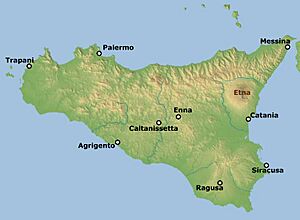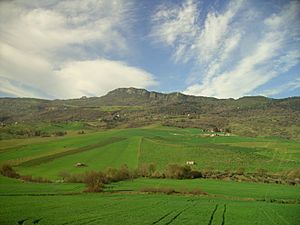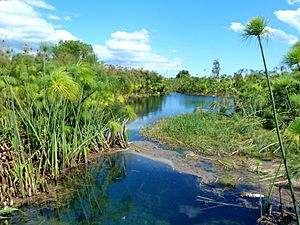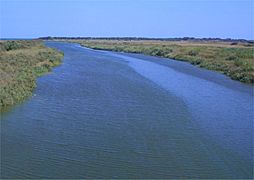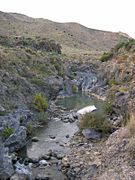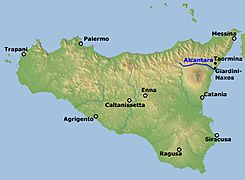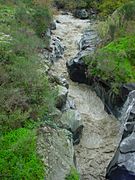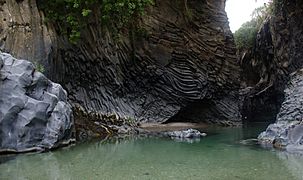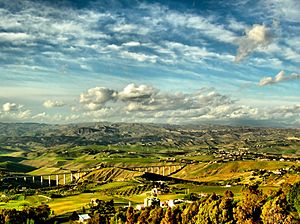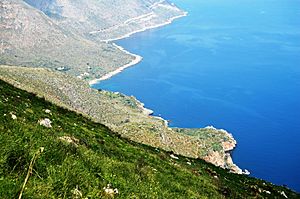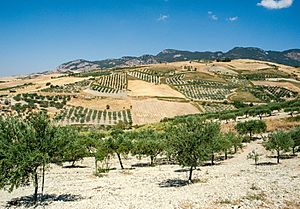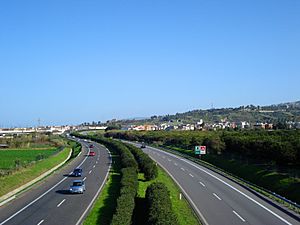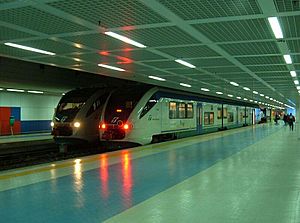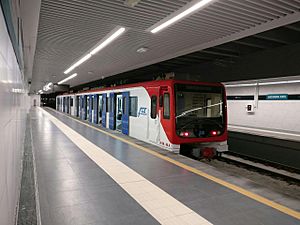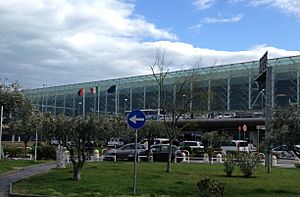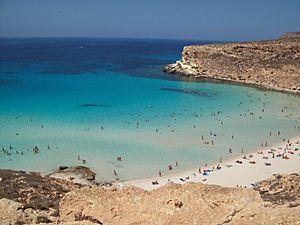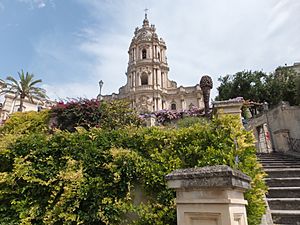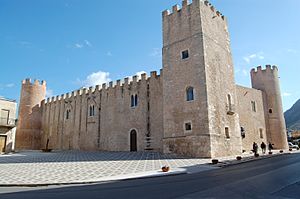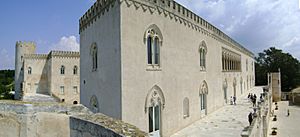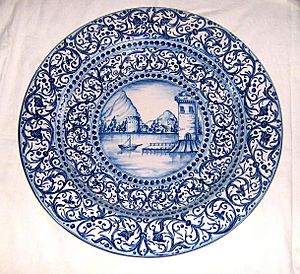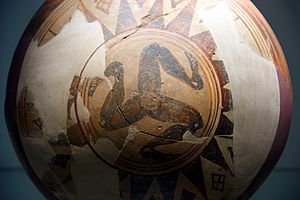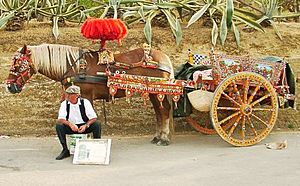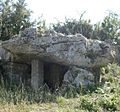Sicily facts for kids
Quick facts for kids
Sicily
Sicilia
|
|||
|---|---|---|---|
|
|||
| Anthem: Madreterra | |||
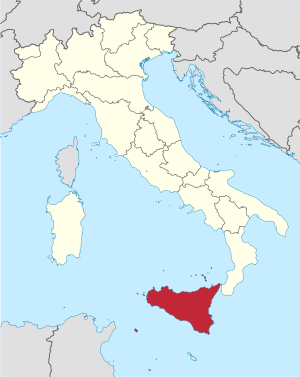 |
|||
| Country | Italy | ||
| Capital | Palermo | ||
| Area | |||
| • Total | 25,711 km2 (9,927 sq mi) | ||
| Population
(2017)(8.3% of Italy)
|
|||
| • Total | 5,029,675 | ||
| • Density | 195.623/km2 (506.662/sq mi) | ||
| Demonym(s) | English: Sicilian Italian: Siciliano (man) Italian: Siciliana (woman) |
||
| Citizenship | |||
| • Italian | 98% | ||
| Time zone | UTC+1 (CET) | ||
| • Summer (DST) | UTC+2 (CEST) | ||
| ISO 3166 code | IT-82 | ||
| GDP (nominal) | €88.1 billion (2017) | ||
| GDP per capita | €17,500 (2017) | ||
| HDI (2017) | 0.836 very high · 21st of 21 |
||
| NUTS Region | ITG | ||
| Website | http://pti.regione.sicilia.it | ||
Sicily is the biggest island in the Mediterranean Sea. It is one of the 20 regions of Italy. Sicily is special because it is one of five autonomous regions in Italy. This means it has more power to make its own rules.
Sicily is located in the middle of the Mediterranean Sea. It is south of the Italian Peninsula, separated by the narrow Strait of Messina. The most famous natural feature is Mount Etna. It is Europe's tallest active volcano and one of the busiest in the world. It is about 3,329 meters (10,922 feet) high. Sicily has a typical Mediterranean climate.
People have lived on Sicily for a very long time, since about 12,000 BC. Around 750 BC, it had many Phoenician and Greek colonies. Later, it was the site of major wars like the Sicilian Wars and the Punic Wars. After the Roman Empire fell, different groups ruled Sicily. These included the Vandals, Ostrogoths, Byzantines, and the Arabs.
The Normans took over and created the Kingdom of Sicily. This kingdom was then ruled by several European families. Sicily became part of Italy in 1860 after a revolt led by Giuseppe Garibaldi. It gained its special autonomous status on May 15, 1946.
Sicily has a very rich and special culture. This includes its art, music, literature, food, and buildings. It also has important ancient sites. Some famous ones are the Necropolis of Pantalica, the Valley of the Temples, Erice, and Selinunte.
Contents
Geography of Sicily
|
Native name:
Sicilia
|
|
|---|---|
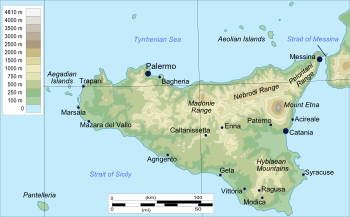
Map of Sicily
|
|
| Lua error in Module:Location_map at line 420: attempt to index field 'wikibase' (a nil value).
Sicily (Italy)
|
|
| Geography | |
| Location | Mediterranean Sea |
| Area | 25,426 km2 (9,817 sq mi) |
| Highest elevation | 3,326 m (10,912 ft) |
| Highest point | Mount Etna |
| Administration | |
|
Italy
|
|
| Regione | Sicily |
| Largest settlement | Palermo (pop. 668,405) |
| Demographics | |
| Population | 5,015,569 (2011) |
| Pop. density | 195 /km2 (505 /sq mi) |
Sicily has a shape that looks like a triangle. Because of this, it is sometimes called Trinacria. To the northeast, the Strait of Messina separates it from mainland Italy. This strait is about 3 km (1.9 mi) wide in the north. It is about 16 km (9.9 mi) wide in the south.
The northern and southern coasts are each about 280 km (170 mi) long. The eastern coast is around 180 km (110 mi) long. The total coastline is about 1,484 km (922 mi). The island itself covers 25,711 square kilometers (9,927 sq mi). The entire autonomous region, including smaller islands, is 27,708 square kilometers (10,700 sq mi).
Most of inland Sicily is hilly. People farm these areas whenever possible. Along the northern coast, you'll find mountain ranges. These include the Madonie (2,000 m or 6,600 ft), Nebrodi (1,800 m or 5,900 ft), and Peloritani (1,300 m or 4,300 ft). These mountains are an extension of the Apennines on the mainland.
The cone of Mount Etna stands out on the eastern coast. In the southeast, there are the lower Hyblaean Mountains, about 1,000 m (3,300 ft) high. In the 1800s, the areas around Enna and Caltanissetta were important for producing sulphur. However, this industry has declined since the 1950s.
Volcanoes of Sicily
Sicily and its nearby small islands have several active volcanoes. Mount Etna is the largest active volcano in Europe. It often erupts, sending black ash over the island. Its height changes with eruptions, currently 3,329 meters (10,922 feet) high. It is the highest mountain in Italy south of the Alps. Etna covers an area of 1,190 square kilometers (460 sq mi). Its base is 140 km (87 mi) around. It is much larger than Italy's other active volcanoes, like Mount Vesuvius. In Greek mythology, the giant monster Typhon was trapped under Mount Etna by Zeus. Mount Etna is a strong symbol of Sicily.
The Aeolian Islands are in the Tyrrhenian Sea, northeast of Sicily. They are a group of volcanoes, including Stromboli. The volcanoes of Vulcano, Vulcanello, and Lipari are also active. Off Sicily's southern coast, the underwater volcano Ferdinandea last erupted in 1831.
Rivers of Sicily
Several rivers flow through Sicily. Most of them run through the central part of the island. They then flow into the sea on the south side. The Salso river flows through parts of Enna and Caltanissetta. It reaches the Mediterranean Sea at the port of Licata.
To the east, the Alcantara river flows through the province of Messina. It enters the sea at Giardini Naxos. The Simeto river flows into the Ionian Sea south of Catania. Other important rivers in Sicily include the Belice and Platani in the southwest.
Climate of Sicily
Sicily has a typical Mediterranean climate. Winters are mild and wet, while summers are hot and dry. Spring and autumn have changing weather. Along the coasts, especially in the southwest, African winds can make summers very hot.
Snow usually falls above 900–1000 meters (2,950–3,280 feet). However, it can also fall in the lower hills. The mountains inland, like Nebrodi, Madonie, and Etna, have a true mountain climate. They get heavy snowfalls in winter. The top of Mount Etna is usually covered in snow from October to May.
In summer, the sirocco wind from the Sahara desert is common. Rainfall is low, and some areas sometimes face water shortages. In 1999, the weather station in Catenanuova recorded a temperature of 48.5°C (119.3°F). This is one of the highest temperatures ever recorded in Europe.
Plants and Animals of Sicily
Sicily has seen a lot of deforestation since Roman times. The island was turned into farmland, which made the climate drier. This led to less rainfall and rivers drying up. The central and southwest parts of Sicily have almost no forests left.
In Northern Sicily, there are three important forests. One is near Mount Etna, another in the Nebrodi Mountains. The third is in the Bosco della Ficuzza's Natural Reserve near Palermo. The Nebrodi Mountains Regional Park is Sicily's largest protected natural area. It covers 86,000 hectares (210,000 acres) and contains the biggest forest in Sicily, called Caronia.
The Hundred Horse Chestnut tree, located on Mount Etna, is very famous. It is one of the largest and oldest known chestnut trees in the world. It is estimated to be between 2,000 and 4,000 years old.
Sicily is home to many different animals. These include foxes, weasels, pine martens, roe deer, and wild boar. You can also find porcupines, hedgehogs, and toads. Birds like the golden eagle, peregrine falcon, hoopoe, and black-winged stilt live here.
The Zingaro Natural Reserve is a great example of Sicily's untouched coastal nature. The waters around Sicily, including the Strait of Messina, are full of marine life. You can see flamingos and even fin whales.
People of Sicily
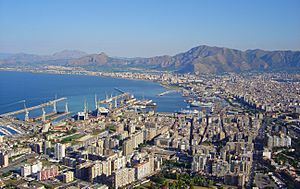

Sicily has a rich mix of different cultures and people. Over time, many groups have lived here. These include the original Italic people, Phoenicians, Carthaginians, Greeks, Romans, Byzantines, Arabs, Normans, and Spaniards. Each group has added to the island's unique culture and the genetic makeup of its people.
About five million people live in Sicily. This makes it the fourth most populated region in Italy.
Major Cities in Sicily
Here are the ten largest cities in Sicily:
| Pos. | Name | Pop. 2017 |
Area (km2) |
Pop. per km2 |
|---|---|---|---|---|
| 1 | Palermo | 668,405 | 159 | 4,207 |
| 2 | Catania | 311,620 | 181 | 1,723 |
| 3 | Messina | 234,293 | 212 | 1,107 |
| 4 | Syracuse | 121,605 | 204 | 596 |
| 5 | Marsala | 82,802 | 242 | 343 |
| 6 | Gela | 74,858 | 277 | 270 |
| 7 | Ragusa | 73,638 | 442 | 166 |
| 8 | Trapani | 67,923 | 272 | 250 |
| 9 | Vittoria | 64,212 | 181 | 354 |
| 10 | Caltanissetta | 62,317 | 416 | 150 |
Economy of Sicily
Sicily is known for its very fertile soil, thanks to volcanic eruptions. The island's pleasant climate also helps farming.
Farming and Fishing in Sicily

The main farm products are wheat, oranges, lemons, and tomatoes. Other important crops include olives, olive oil, artichokes, and almonds. Grapes and pistachios are also grown for wine and food. Cattle and sheep are raised, and cheese production is very important. Famous cheeses include Ragusano DOP and Pecorino Siciliano DOP. Ragusa is known for its honey and chocolate.
Sicily is the third largest wine producer in Italy. The region is famous for its strong Marsala wines. In recent years, winemaking has improved, and Sicilian wines are becoming more popular. A well-known local grape is Nero d'Avola. Other important local grapes include Nerello Mascalese and Frappato. Sicily also produces high-quality wines using grapes like Syrah and Chardonnay.
Sicily is also known for its liqueurs, such as Amaro Averna. Fishing is another key part of Sicily's economy. Important catches include tuna, sardines, and swordfish. Mazara del Vallo is the largest fishing center in Sicily.
Industries and Factories in Sicily
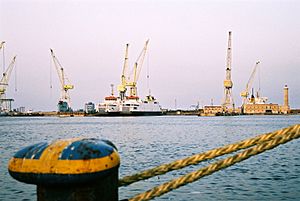
Improvements in Sicily's roads have helped industries grow. The region has three main industrial areas:
- Catania Industrial District: This area has many food industries. It also has a major European electronics center called Etna Valley. This area is home to international companies like STMicroelectronics.
- Syracuse Petrochemical District: This district has chemical industries and oil refineries. It also has important power stations.
- Enna Industrial District: This newer district mainly focuses on food industries.
In Palermo, there are important shipyards like Fincantieri. There are also factories for mechanical engineering, publishing, and textiles. Chemical industries are also found in the Province of Messina and the Province of Caltanissetta.
Sicily has oil, natural gas, and asphalt fields in the southeast, near Ragusa. There are also large salt deposits in Central Sicily. The Province of Trapani is one of Italy's biggest producers of sea salt.
Transportation in Sicily
Roads in Sicily
Highways in Sicily have grown a lot in the last forty years. The most important roads are the motorways, known as autostrade, in the north of the island. Many parts of the motorway network are built on tall pillars. This is because Sicily has a lot of mountains.
Railways in Sicily
The first railway in Sicily opened in 1863. Today, all Sicilian provinces have railway services. These connect most major cities and towns. Trenitalia operates this service. Over 60% of the 1,378 km (856 mi) of railway tracks are electric. The remaining 583 km (362 mi) use diesel engines.
Most lines are single-track. Only 169 km (105 mi) are double-track. These double tracks serve the main routes: Messina-Palermo and Messina-Catania-Syracuse. The Ferrovia Circumetnea is a special narrow-gauge railway. It still operates and goes around Mount Etna. You can also take trains from Sicily's major cities to Naples, Rome, and Milan. These trains are loaded onto ferries to cross the Strait of Messina.
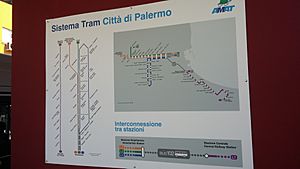
In Catania, there is an underground railway service called the metropolitana. In Palermo, the national railway operator Trenitalia runs a commuter rail service. Palermo also has four tram lines. Messina is served by a tram line.
Airports in Sicily
Mainland Sicily has several airports. These airports offer flights to many places in Italy and Europe. Some flights also go to destinations outside Europe.
Ports in Sicily
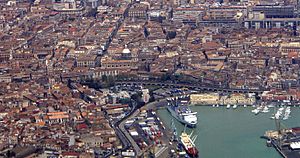
Sicily is connected by sea through many ferry routes and cargo ports. Cruise ships regularly dock in all major cities.
- To Mainland Italy: Ferries connect Messina to Villa San Giovanni and Salerno. Palermo has routes to Genoa, Civitavecchia, and Naples. Catania has a route to Naples.
- To Sicily's Small Islands: The port of Milazzo serves the Aeolian Islands. Trapani and Marsala connect to the Aegadian Islands. Porto Empedocle serves the Pelagie Islands. From Palermo, you can go to Ustica and Sardinia.
- International Connections: Palermo and Trapani have weekly services to Tunisia. There is also a daily service between Malta and Pozzallo.
- Commercial and Cargo Ports: The port of Augusta is one of Italy's largest cargo ports. Other major cargo ports include Palermo, Catania, and Trapani.
- Touristic Ports: Many ports along the Sicilian coast serve private boats. Key ports for this are in Marina di Ragusa, Riposto, and Syracuse. Palermo is also a big center for boat rentals in the Mediterranean.
- Fishing Ports: Sicily has many fishing ports. The most important is in Mazara del Vallo.
Tourism in Sicily
Sicily's sunny climate, beautiful scenery, delicious food, rich history, and amazing buildings attract many tourists. People visit the island all year round, but the busiest time is summer. Mount Etna, the beaches, ancient sites, and big cities like Palermo are popular. The old town of Taormina and the nearby Giardini Naxos also draw visitors. The Aeolian Islands, Erice, and Agrigento are also favorite spots. Agrigento has some of the best-preserved ancient Greek temples. Many Mediterranean cruise ships stop in Sicily.
Some scenes from Hollywood and Italian films have been shot in Sicily. This has made Sicily even more popular as a tourist spot.
UNESCO World Heritage Sites in Sicily
Sicily is home to seven UNESCO World Heritage Sites. These are special places recognized for their global importance.
- Valle dei Templi (1997): Located in Agrigento, this site has amazing examples of ancient Greek art and buildings. It is a major attraction in Sicily.
- Villa Romana del Casale (1997): This Roman villa was built in the early 4th century. It is near Piazza Armerina. It has the largest and most complex collection of Roman mosaics in the world.
- Aeolian Islands (2000): These are a group of volcanic islands in the Tyrrhenian Sea. They are named after Aeolus, the Greek demigod of winds. They are a popular tourist spot, especially in summer.
- Late Baroque Towns of the Val di Noto (2002): These towns show the best of Baroque art in Europe. They include Caltagirone, Catania, Modica, Noto, Ragusa, and Syracuse.
- Necropolis of Pantalica (2005): This is a large ancient burial ground in Sicily. It has over 5,000 tombs from 13th to 7th centuries BC. Syracuse is also known for its rich Greek history and architecture.
- Mount Etna (2013): This active volcano is always busy. It has inspired many myths and legends since ancient times.
- Arab-Norman Palermo and the cathedral churches of Cefalù and Monreale (2015): This site includes nine buildings from the Norman kingdom of Sicily (1130–1194).
Ancient Sites in Sicily
Because many cultures lived in Sicily, the island has a huge variety of ancient sites. Some of the best-preserved Greek temples and structures are found here. Here are some of the major archaeological sites:
- Greek Sites: Syracuse, Agrigento, Segesta, Selinunte, Gela.
- Phoenician Sites: Motya, Soluntum, Marsala, Palermo.
- Roman Sites: Piazza Armerina, Centuripe, Taormina, Palermo.
- Arab Sites: Palermo, Mazara del Vallo.
Castles in Sicily
Sicily has hundreds of castles. Here are some of the most important ones:
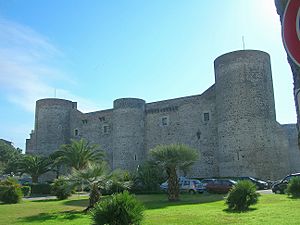
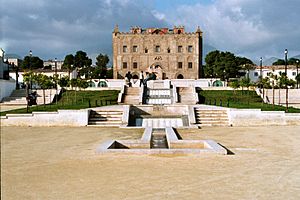
| Province | Castles | Commune |
|---|---|---|
| Caltanisetta | Castello Manfredonico | Mussomeli |
| U Cannuni | Mazzarino | |
| Castelluccio di Gela | Gela | |
| Catania | Castello Ursino | Catania |
| Castello Normanno | Adrano | |
| Castello Normanno | Paternò | |
| Castello di Aci | Aci Castello | |
| Messina | Forte dei Centri | Messina |
| Castello di Milazzo | Milazzo | |
| Castello di Sant'Alessio Siculo | Sant'Alessio Siculo | |
| Castello di Pentefur | Savoca | |
| Castello di Schisò | Giardini Naxos | |
| Palermo | Zisa, Palermo | Palermo |
| Castello di Caccamo | Caccamo | |
| Castello di Carini | Carini | |
| Castello dei Ventimiglia | Castelbuono | |
| Ragusa | Castello di Donnafugata | Ragusa |
| Torre Cabrera | Pozzallo | |
| Castello Dei Conti | Modica | |
| Syracuse | Castello Maniace | Syracuse |
| Trapani | Castello di Venere | Erice |
| Castle of the Counts of Modica | Alcamo | |
| Castle of Calatubo | Alcamo |
Coastal Towers of Sicily
The Coastal towers in Sicily are 218 old watchtowers along the coast. The first towers in Sicily were built in the 1300s. From 1360, the main threat came from pirates from North Africa. These were mainly Barbary pirates. In 1516, the Turks settled in Algiers, and the pirate Hayreddin Barbarossa became very active.
Most of the towers you see today were built between 1583 and 1584. They followed designs by the architect Camillo Camilliani. Later, in the 1800s, new towers were built like the British Martello towers. These were designed to handle new types of cannons. As piracy in the Mediterranean decreased, fewer coastal towers were built in the 19th century.
Culture of Sicily
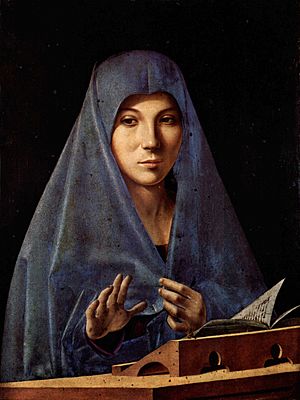
Sicily has a long history with the arts. Many famous poets, writers, philosophers, and artists have come from the island. This tradition goes back to the Greek philosopher Archimedes. He was from Syracuse and is known as one of the greatest mathematicians ever. Other early Sicilian-Greek thinkers include Gorgias and Empedocles.
Art and Buildings in Sicily
Terracotta ceramics from Sicily are very famous. The art of ceramics started with the ancient Sicanians. It became even better during the Greek period and is still important today. Caltagirone is a key center for making artistic ceramics. Famous painters from Sicily include Renaissance artist Antonello da Messina and Renato Guttuso. Giorgio de Chirico, born in Greece, is often called the "father of Surrealist art". Important architects include Filippo Juvarra and Ernesto Basile.
Languages of Sicily
Today, most people in Sicily speak both Italian and Sicilian. Sicilian is a unique and old Romance language. Some Sicilian words come from Greek, Catalan, French, Arabic, and Spanish. A language related to Sicilian is also spoken in Calabria and Salento. Sicilian also had a big influence on the Maltese language. However, Sicilian is mostly used in informal settings, like with family. Often, it is replaced by "regional Italian of Sicily," which is a mix of Italian and Sicilian.
Food of Sicily
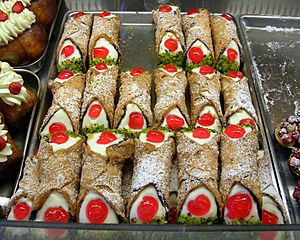
Sicily is famous for its wide range of delicious foods and wines. It is sometimes called God's Kitchen. Each part of Sicily has its own special dishes. For example, Cassata is typical of Palermo. The ingredients are usually rich in flavor but affordable. Sicilian savory dishes are considered healthy. They use fresh vegetables and fruits like tomatoes, artichokes, and olives. These are often combined with fresh seafood like tuna, swordfish, and sardines.
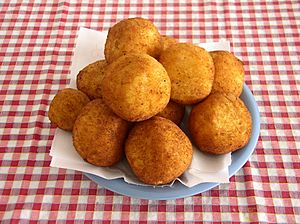
The most famous part of Sicilian food is its rich sweet dishes. These include ice creams and pastries. Cannoli are tube-shaped fried pastry shells filled with sweet ricotta cheese. They are strongly linked to Sicily worldwide. Other notable sweets include biancomangiare, biscotti ennesi, and cassata.
Like other parts of southern Italy, pasta is very important in Sicilian cooking. Rice is also used, for example, in arancine (fried rice balls). Sicily also makes its own cheeses from cow's and sheep's milk, like pecorino and caciocavallo. Spices like saffron, nutmeg, and cinnamon were brought by the Arabs. Parsley is used a lot. While seafood is common, meat dishes like goose, lamb, and rabbit are also found. The Normans and Swabians first brought a love for meat dishes to the island.
Symbols of Sicily
Sicily has several cultural symbols, including flags, carts, and natural features.
The Flag of Sicily is a regional symbol. It was first used in 1282. It features the trinacria (a triskelion) in the middle. This symbol has the winged head of Medusa and three wheat ears. The three bent legs are thought to represent the three points of the island of Sicily. The colors represent the cities of Palermo and Corleone. These were the first two cities to unite against the Angevin rulers. The flag became official in January 2000.
The Triskelion is an ancient symbol of the region. It appears on Greek coins from Syracuse from around 317–289 BC. This symbol dates back to when Sicily was part of Magna Graecia (Greater Greece). Pliny the Elder said the triskelion came from Sicily's triangular shape. The island has three large capes that are far apart: Pelorus, Pachynus, and Lilybæum.
The Sicilian cart is a very decorated and colorful cart. It is pulled by a horse or donkey. Horses were used in cities and flat areas. Donkeys or mules were used in rougher areas for heavy loads. The cart has two wheels and is mostly handmade from wood with iron parts.
The Sicilian coppola is a traditional flat cap worn by men in Sicily. It was first used by English nobles in the late 1700s. In Sicily, it became popular in the early 1900s as a driving cap. The coppola is usually made of tweed. Today, it is a clear symbol of Sicilian heritage.
Images for kids
-
The Sicilian wall lizard endemic to Sicily and the Aegadian Islands
-
Ruins of the ancient Phoenician city of Motya
-
Historic map of Sicily by Piri Reis
-
Arabesque on a wall in the Cuba Palace in Palermo
-
Depiction of the Sicilian Vespers
-
Sicilian Baroque in Catania.
-
The city of Palermo
-
A Sicilian café in New York 1889
-
Syracuse Cathedral
-
Teatro Massimo, Palermo
-
Giuseppe Gibilisco, pole vaulter from Syracuse, 2003 World Champion and bronze Olympic medalist
-
Sicilian arrotino at a living nativity scene wearing traditional Sicilian clothing
-
The "Misteri", a Religious festival in Trapani
-
A carnival float in Acireale
-
The marionettes used in the Opera dei Pupi
See also
 In Spanish: Sicilia para niños
In Spanish: Sicilia para niños




